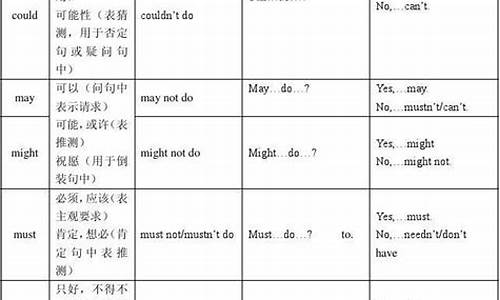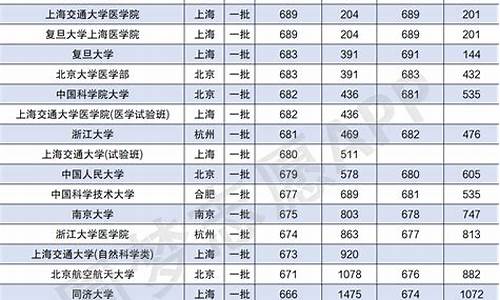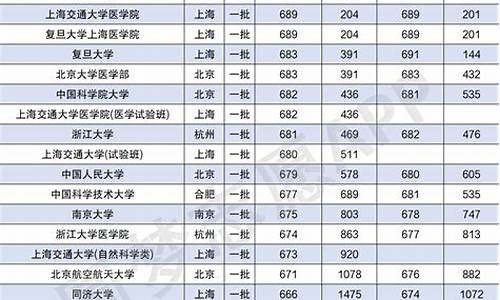您现在的位置是: 首页 > 招生信息 招生信息
动词高考考点_高考英语动词用法
tamoadmin 2024-05-21 人已围观
简介一、非谓语动词种类及句法功能(一)概述:在英语中,不作句子谓语,而具有除谓语外其他语法功能的动词,叫做非谓语动词。非谓语动词有动词不定式(the Infinitive);动名词(the Gerund);现在分词(the Present Participle);过去分词(the Past Participle)。 1.非谓语动词与谓语动词的相同点有: (1)如果是及物动词都可

一、非谓语动词种类及句法功能
(一)概述:
在英语中,不作句子谓语,而具有除谓语外其他语法功能的动词,叫做非谓语动词。非谓语动词有动词不定式(the Infinitive);动名词(the Gerund);现在分词(the Present Participle);过去分词(the Past Participle)。
1.非谓语动词与谓语动词的相同点有:
(1)如果是及物动词都可与宾语连用,例如:
They built a garden.
They suggested building a garden.
(2)都可以被状语修饰:
The suit fits him very well.
The suit used to fit him very well.
(3)都有主动与被动, “体”式(一般式;进行式;完成式)的变化。例如:
He was punished by his parents.(谓语动词被动语态)
He avoided being punished by his parents.(动名词的被动式)
We have written the composition.(谓语动词的完成时)
Having written the composition, we handed it in.(现在分词的完成式)
(4)都可以有逻辑主语
They started the work at once.(谓语动词的逻辑主语)
The boss ordered them to start the work.(动词不定式的逻辑主语)
We are League members.(谓语动词的主语)
We being League member, the work was well done.
(现在分词的逻辑主语)
2、非谓语动词与谓语动词的不同点有:
(1)非谓语动词可以有名词作用(如动词不定式和动名词),在句中做主语、宾语、表语。
(2)非谓语动词可以有形容词作用(如动词不定式和分词),在句中做定语、表语或宾语补足语。
(3)非谓语动词可以有副词作用(如动词不定式和分词),在句中作状语。
(二)非谓语动词的句法功能:
二、非谓语动词用法:
(一)动词不定式:(to)+do,具有名词、形容词、副词的特征。
1.不定式的形式:(以动词write为例)
否定式:not + (to) do
(1)一般式:不定式的一般式所表示的动作与谓语动词动作同时发生或发生在谓语动词动作之后,
例如:
I'm glad to meet you.
He seems to know a lot.
We plan to pay a visit.
He wants to be an artist.
The patient asked to be operated on at once.
The teacher ordered the work to be done.
(2)进行式:不定式的进行式所表示的动作与谓语动词动作同时发生,例如:
The boy pretended to be working hard.
He seems to be reading in his room.
(3)完成式:不定式的完成式表示的动作发生在谓语动词动作之前,例如:
I regretted to have told a lie.
I happened to have seen the film.
He is pleased to have met his friend.
2.不定式的句法功能:
(1)作主语:
To finish the work in ten minutes is very hard.
To lose your heart means failure.
动词不定式短语作主语时,常用it作形式主语,例如上面两句可用如下形式:
It is very hard to finish the work in ten minutes.
It means failure to lose your heart.
(2)作表语:
Her job is to clean the hall.
He appears to have caught a cold.
(3)作宾语:
常与不定式做宾语连用的动词有:want, hope, wish, offer, fail, plan, learn, pretend, refuse, manage, help, agree, promise, prefer, 如果不定式(宾语)后面有宾语补足语,则用it作形式宾语,真正的宾语(不
定式)后置,放在宾语补足语后面,例如:
Marx found it important to study the situation in Russia.
动词不定式也可充当介词宾语,如:
I have no choice but to stay here.
He did nothing last Sunday but repair his bike.
动词不定式前有时可与疑问词连用,如:
He gave us some advice on how to learn English.
(4)作宾语补足语:
在复合宾语中,动词不定式可充当宾语补足语,如下动词常跟这种复合宾语:want, wish, ask, tell, order, beg, permit, help, advise, persuade, allow, prepare, cause, force, call on, wait for, invite.
此外,介词有时也与这种复合宾语连用,如:
With a lot of work to do, he didn't go to the cinema.
有些动词如make, let, see, watch, hear, feel, have等与不带有to的不定式连用,但改为被动语态时,不定式要加to, 如:
I saw him cross the road.
He was seen to cross the road.
(5)作定语:
动词不定式作定语,放在所修饰的名词或代词后。与所修饰名词有如下关系:
①动宾关系:
I have a meeting to attend.
注意:不定式为不及物动词时,所修饰的名词如果是地点、工具等,应有必要的介词,如:
He found a good house to live in.
The child has nothing to worry about.
What did you open it with?
如果不定式修饰time, place, way,可以省略介词:
He has no place to live.
This is the best way to work out this problem.
如果不定式所修饰名词是不定式动作承受者,不定式可用主动式也可用被动式:
Have you got anything to send?
Have you got anything to be sent?
②说明所修饰名词的内容:
We have made a plan to finish the work.
③被修饰名词是不定式逻辑主语:
He is the first to get here.
(6)作状语:
①表目的:
He worked day and night to get the money.
She sold her hair to buy the watch chain.
注意不定式放句首时,逻辑主语与句子主语要一致:
wrong:To save money, every means has been tried.
right:To save money, he has tried every means.
wrong:To learn English well, a dictionary is needed.
right:To learn English well, he needs a dictionary.
②表结果:
He arrived late to find the train gone.
常用only放在不定式前表示强调:
I visited him only to find him out.
③表原因:
They were very sad to hear the news.
④表程度:
It's too dark for us to see anything.
The question is simple for him to answer.
(7)作独立成分:
To tell you the truth, I don't like the way he talked.
(8)不定式的省略:保留to省略do动词。
If you don't want to do it, you don't need to.
(9)不定式的并列:第二个不定式可省略to。
He wished to study medicine and become a doctor.
(二)动名词:
动名词既具有动词的一些特征,又具有名词的句法功能。
1.动名词的形式:
否定式:not + 动名词
(1)一般式:
Seeing is believing. 眼见为实。
(2)被动式:
He came to the party without being invited.他未被邀请就来到了晚会。
(3)完成式:
We remembered having seen the film. 我们记得看过这部**。
(4)完成被动式:
He forgot having been taken to Guangzhou when he was five years old.
他忘记五岁时曾被带到广州去过。
(5)否定式:not + 动名词
I regret not following his advice. 我后悔没听他的劝告。
(6)复合结构:物主代词(或名词所有格)+ 动名词
He suggested our trying it once again. 他建议我们再试一次。
His not knowing English troubled him a lot.
他不懂英语给他带来许多麻烦。
2.动名词的句法功能:
(1)作主语:
Reading aloud is very helpful. 朗读是很有好处的。
Collecting stamps is interesting. 集邮很有趣。
当动名词短语作主语时常用it作形式主语。
It's no use quarrelling.争吵是没用的。
(2)作表语:
In the ant city, the queen's job is laying eggs.
在蚂蚁王国,蚁后的工作是产卵。
(3)作宾语:
They haven't finished building the dam. 他们还没有建好大坝。
We have to prevent the air from being polluted.
我们必须阻止空气被污染。
注意动名词既可作动词宾语也可作介词宾语,如上面两个例句。此外,动名词作宾语时,若跟有宾语补足语,则常用形式宾语it,例如:
We found it no good making fun of others. 我们发现取笑他人不好。
要记住如下动词及短语只跟动名词作宾语:
enjoy, finish, suggest, avoid(避免), excuse ,delay, imagine, keep, miss, consider, admit(承认),deny(否认), mind, permit, forbid, practise, risk(冒险), appreciate(感激), be busy, be worth, feel like, can't stand, can't help(情不自禁地), think of, dream of, be fond of, prevent…(from),keep …from, stop…(from),protect…from, set about, be engaged in, spend…(in), succeed in, be used to, look forward to, object to, pay attention to, insist on, feel like
(4)作定语:
He can't walk without a walking-stick. 他没有拐杖不能走路。
Is there a swimming pool in your school? 你们学校有游泳池吗?
(5)作同位语:
The cave, his hiding-place is secret. 那个山洞,他藏身的地方很秘密。
His habit, listening to the news on the radio remains unchanged.
他收听收音机新闻节目的习惯仍未改变。
(三)现在分词:
现在分词既具有动词的一些特征,又具有形容词和副词的句法功能。
1、现在分词的形式:
否定式:not + 现在分词
(1)现在分词的主动语态:现在分词主动语态的一般式表示与谓语动词所表示的动作同时发生,完成
式表示的动作在谓语动词所表示的动作之前发生,常作状语。例如:
They went to the park, singing and talking. 他们边唱边说向公园走去。
Having done his homework, he played basket-ball. 做完作业,他开始打篮球。
(2)现在分词的被动语态:一般式表示与谓语动词同时发生的被动的动作,完成式表示发生在谓语动
词之前的被动的动作。
The problem being discussed is very important. 正在被讨论的问题很重要。
Having been told many times, the naughty boy made the same mistake.
被告诉了好几遍,这个淘气的孩子又犯了同一个错误。
2.现在分词的句法功能:
(1)作定语:现在分词作定语,当分词单独做定语时,放在所修饰的名词前;如果是分词短语做定语
放在名词后。
In the following years he worked even harder.
在后来的几年中,他学习更努力了。
The man speaking to the teacher is our monitor's father.
正与老师谈话的那个人是我们班长的父亲。
现在分词作定语相当于一个定语从句的句法功能,如:in the following years也可用in the years that followed; the man speaking to the teacher可改为the man who is speaking to the teacher.
(2)现在分词作表语:
The film being shown in the cinema is exciting. 正在这家上演的**很棒。
The present situation is inspiring. 当前的形势鼓舞人心。
be + doing既可能表示现在进行时,也可能是现在分词做表语,它们的区别在于be + doing表示进行的动作是进行时,而表示特征时是系动词be与现在分词构成系表结构。
(3)作宾语补足语:
如下动词后可跟现在分词作宾语补足语:
see, watch, hear, feel, find, get, keep, notice, observe, listen to, look at, leave, catch等。例如:
Can you hear her singing the song in the next room? 你能听见她在隔壁唱歌吗?
He kept the car waiting at the gate. 他让小汽车在门口等着。
(4)现在分词作状语:
①作时间状语:
(While) Working in the factory, he was an advanced worker.
在工厂工作时,他是一名先进工人。
②作原因状语:
Being a League member, he is always helping others. 由于是共青团员,他经常帮助他人。
③作方式状语,表示伴随:
He stayed at home, cleaning and washing. 他呆在家里,又擦又洗。
④作条件状语:
(If) Playing all day, you will waste your valuable time.
要是整天玩,你就会浪费宝贵的时间。
⑤作结果状语:
He dropped the glass, breaking it into pieces. 他把杯子掉了,结果摔得粉碎。
⑥作目的状语:
He went swimming the other day. 几天前他去游泳了。
⑦作让步状语:
Though raining heavily, it cleared up very soon.
虽然雨下得很大,但不久天就晴了。
⑧与逻辑主语构成独立主格:
I waiting for the bus, a bird fell on my heard.
我等汽车时,一只鸟落到我头上。
All the tickets having been sold out, they went away disappointedly.
所有的票已经卖光了,他们失望地离开了。
Time permitting, we'll do another two exercises.
如果时间允许,我们将做另两个练习。
有时也可用with (without) +名词(代词宾格)+分词形式
With the lights burning, he fell asleep. 他点着灯睡着了。
⑨作独立成分:
udging from(by) his appearance, he must be an actor.
从外表看,他一定是个演员。
Generally speaking, girls are more careful. 一般说来,女孩子更细心。
(四)过去分词:
过去分词只有一种形式:规则动词由动词原形加词尾-ed构成。不规则动词的过去分词没有统一的规则要求,要一一记住。
过去分词的句法功能:
1.过去分词作定语:
Our class went on an organized trip last Monday. 上周一我们班开展了一次有组织的旅行。
Those elected as committee members will attend the meeting. 当选为委员的人将出席这次会。
注意当过去分词是单词时,一般用于名词前,如果是过去分词短语,就放在名词的后面。过去分词做定语相当于一个被动语态的定语从句。
2.过去分词作表语:
The window is broken. 窗户破了。
They were frightened at the sad sight. 他们对眼前悲惨的景象感到很害怕。
注意:be + 过去分词,如果表示状态是系表结构,如果表示被动的动作是被动语态。区别:
The window is broken.(系表)
The window was broken by the boy.(被动)
有些过去分词是不及物动词构成的,不表示被动,只表示完成。如:
boiled water(开水) fallen leaves(落叶)
newly arrived goods(新到的货) the risen sun(升起的太阳)
the changed world(变了的世界)
这类过去分词有:gone, come, fallen, risen, changed, arrived, returned, passed等。
3.过去分词作宾语补足语:
I heard the song sung several times last week.
上周我听见这首歌被唱了好几次。
有时过去分词做with短语中的宾语补足语:
With the work done, they went out to play. 工作做完了,他们出去玩去了。
4.过去分词作状语:
Praised by the neighbours, he became the pride of his parents.
受到邻居们的表扬,他成为父母的骄傲。(表示原因)
Once seen, it can never be forgotten.
一旦它被看见,人们就忘不了。(表示时间)
Given more time, I'll be able to do it better.
如果给予更多的时间,我能做得更好。(表示条件)
Though told of the danger, he still risked his life
2011年高考英语第二轮热点专题复习——非谓语动词
规律方法
1.考查立意较低,主要考查的是非谓语的一些最基本的用法。但是,题目的设置注重了情景化和结构复杂化,加大了考生对题干句的理解难度。
2.设问的角度呈现出多样化趋势,不仅仅是非谓语间的互相干扰。
命题趋势
不容置疑,高考将继续加强对非谓语动词的考查,试题的特征将继续呈现出“情景化”和“设问角度的多样化”的趋势,但试题的难度将会有所控制。
突破方法
1.非谓语动词的用法是一个系统性、综合性很强的语言点,切不可记住几个条条框框就去乱套。真正领悟非谓语动词的用法要具备以下基础知识:
① 具有句子结构的知识,要分得清简单句与复合句,陈述句与祈使句。
② 具有简单句最基本的五种句型的知识,要分得清双宾语和复合宾语。
③ 具有扎实而丰富的动词知识,要分得清及物动词和不及物动词,双宾动词和复宾动词。一些最基础最常用的动词的用法应当烂熟于胸。
④ 具备各种复合句的知识,能够拆析30词左右长度的复合长、难句。
2.理解分析非谓语动词的句法功能,重点掌握不定式、动名词作宾语的区别;不定式、分词作补语的区别;不定式、分词作状语的区别;独立主格的用法;不定式、分词作定语的区别。
3.解答考查非谓语动词的题目时,一定要保持头脑冷静。一般要遵循以下解题思路:
① 解析句子结构,确定设空在句子中充当的功能(如状语、定语或宾补);
② 找准相关动词的逻辑主语,确定该动词与逻辑主语是什么关系(主动还是被动);
③ 搜索句子中相关的时间信息,确定非谓语动词的恰当形式;
④ 将该选项置入空中,看是否能够做到字从意顺,或是否能传达有效信息、完成交际任务。
知识清单
清单一 非谓语动词的句法功能
名称 主语 宾语 宾语补足语 表语 定语 状语
不定式 √ √ √ √ √ √
动名词 √ √ √ √
现在分词 √ √ √ √
过去分词 √ √ √ √
清单二 分词、不定式作宾补用法要点
一、分词、不定式作宾语补足语的区别
1.感官动词see, watch, observe, look at, hear, listen to, notice 等和使役动词have 后面的宾补有三种形式,即原形动词(不带to 的不定式)、现在分词和过去分词。现在分词表主动或正在进行,过去分词表被动或完成,动词原形表主动和完成。如:
I heard her sing an English song just now.
刚才我听见她唱了一首英文歌。
I heard her singing and English song when I passed by her room yesterday.
昨天经过她房间时,我听见她在唱英文歌。
I heard the English song sung many times.
我多次听到有人唱这首英文歌。
注意:不及物动词的过去分词作宾补表完成和状态。如:
I looked down at my neck and found my necklace gone. (状态)
I was surprised to find my hometown changed so much. (完成)
2.leave 后接三种形式作宾补时,其中的leave 保留了原来之义“留下”,但表达的确切之义应是“使……处于某种状态)。
leave sb. doing sth. 让某人一直做某事
(宾语和宾补之间是主谓关系,表示动作正在进行。)
leave sth. undone 留下某事未做
(宾语和宾补之间是动宾关系,表示被动和完成,一般以undone, unfinished, unsettled, untouched 为多)
leave sb. to do sth. 留下某人做某事
leave sth. to be done 留下某事要做
(不定式表示将来的动作。)
如:It’s wrong of you to leave the machine running.
你让机器一直开着是不对的。(主动,正在进行)
The guests left most of the dishes untouched, because they didn’t taste delicious.
客人们没有动大部分菜,因为它们尝起来不可口。(被动,完成)
He left, leaving me to do all the rest work.
他走了,留下我一人去做剩余的工所有工作。(主动,将来)
We hurriedly ended our meeting, leaving many problems to be settled.
我们匆匆忙忙导结束了会议,留下了很多问题等待解决。(被动,将来)
3.have, get 后接三种形式作宾补时,其中heave, get 表示“使、让、叫”之意。
① have sth. done = get sth. done “使/让某事由别人去做”(叫/让某人做某事)。如
I’ll have /get my bike repaired tomorrow.
此外,have sth. done 还表示“使遭受……”之意。如
Tom had his leg broken while playing football.
Mr. Smith had his house broken into while he was away on holiday.
② have sb. / sth. doing 使/让某人/物持续地做某事(现在分词表示主动,正在进行)
get sb. / sth. doing 使某人/物开始行动起来
如:The peasants had the tractor working day and night at the harvest time.
农忙时,农民们让拖拉机夜以继日地干活。
The captain got the soldiers moving toward the front after a short rest.
休息了片刻之后,上尉让士兵们开始朝前线行进起来。
注意:“have sb. doing”若用于否定句中,其中have 有“容忍”之意。如:
I won’t have you speaking to your parents like that.
我不会让你那样子跟你的父母说话。
Don’t have the water running all the time.
不要让水流个不停。
③ have sb. do sth. (get sb. to do sth. ) 使/让/叫某人去做某事
如:Mother had me go to the shop and buy some salt.
I can’t get him to stop smoking. He won’t listen to me.
二、下列动词后跟带to 的不定式作补语:
advise, allow, ask, beg, cause, encourage, expect, forbid, force, get, intend, invite, like, love, order, persuade, prefer, require, teach, tell, want, warn, wish, think, wait for, call on, depend on 等。如:
① An army spokesman stressed that all thd soldiers had been ordered to issue clear warning before firing any shots.
② The teacher asked us not to make so much noise.
③ The flu is believed to be caused by viruses that like to reproduce in the cells inside the human nose and throat.
三、不定式、现在分词作宾补小窍门
下列动词后在主动语态中用不带to 的不定式作补语,但在被动语态中要加上to:
它们是“吾看三室两厅一感觉”——5看(look at, see, watch, notice, observe);3使(make, let, have);2听(listen to, hear);1感觉(fell)。以上动词还可用现在分词作宾语补足语(5+3+2+1-2+4):即以上动词除let, make 外都可以用现在分词作宾语补足语,此外find, catch, keep, lave 也可以用现在分词作宾语补足语。如:
At that time, I found him crying in the street.
He was caught stealing.
I’m sorry to have kept you waiting for such a long time.
The missing boys were last seen playing near the river.
清单三 不定式、分词作定语用法要点
一、不定式作定语
1.作定语的不定式如果是不及物动词,或者不定式所修饰的名词或代词是不定式动作的地点、工具等,不定式后面须有相应的介词。如:
The Browns have a comfortable house to live in.
There is nothing to worry about.
Please give me a knife to cut with.
Here is some paper for you to write on.
但是,不定式所修饰的名词如果是time, place 或way时,不定式后面的介词习惯上省去。如:
He had no money and no place to live (in).
We found a way to solve this problem (in).
2.当作定语的不定式所修饰的名词或代词是不定式动作的承受者时,不定式既可以用主动语态,也可用被动语态,但其含义有所不同。试比较:
Have you anything to send ? 你有什么东西要寄吗?
(不定式to send 的动作执行者是“你”)
Have you anything to be sent ? 你有什么要(我或别人)寄的东西吗?
(不定式to be sent 的动作执行者是“我”或“别人”)
3.用不定式作定语的几种情况:
不定式表将来:
I borrowed some books to read during my holiday.
用来修饰被序数词、最高级或no, all, any 等限定的中心词。如:
He was the best man to do the job.
She was the first woman to sin the gold medal in the Olympic Games.
Women and children were the first to get into the lifeboats.
用来修饰的词是抽象名词时,常见的有:ability, chance, idea, fact, excuse, promise, answer, reply, attempt, belief, way, reason, moment, time 等。如:
Do you have the ability to read and write English ?
I have to chance to go sight –seeing.
二、分词作定语
1.作定语的及物动词分词形式为:V –ing; being + 过去分词;过去分刻画 。当被修饰的名词与分词为主动关系时,用V –ing;当被修饰的名词与分词为被动关系且表正在进行时,用being + 过去分词;当被修饰的名词与分词为被动关系且表完成时,用过去分词。例如:
The houses being built are for the teachers.
The broken glass is Tom’s.
I have never seen a more moving movie.
2.作定语的不及物动词分词形式为:V –ing 和过去分词。V –ing 表示正在进行;过去分词表示已经完成。如:
falling leaves 正落的叶子 fallen leaves 落下的叶子
boiling water 正沸腾的水 boiled water 沸腾过的水(白开水)
三、不定式、过去分词和现在分词被动式作定语的区别
这三种形式作定语,主要是体现在动作的发生时间上。过去分词表示的动作或是在谓语所表示的动作之前发生,或是没有一定的时间性。如:
Have you read the novel written by Dickens ?
He is man loved and respected by all.
Don’t use words, expressions, or phrases known only to people with specific knowledge.
现在分词的被动式作定语时表示的动作正在发生或是与谓语动词所表示的动作同时发生。如:
Listen ! The song being sung is very popular with the students.
不定式的被动式作定语时,表示一个未来的动作。如:
The question to be discussed at the tomorrow’s meeting is a very important one.









